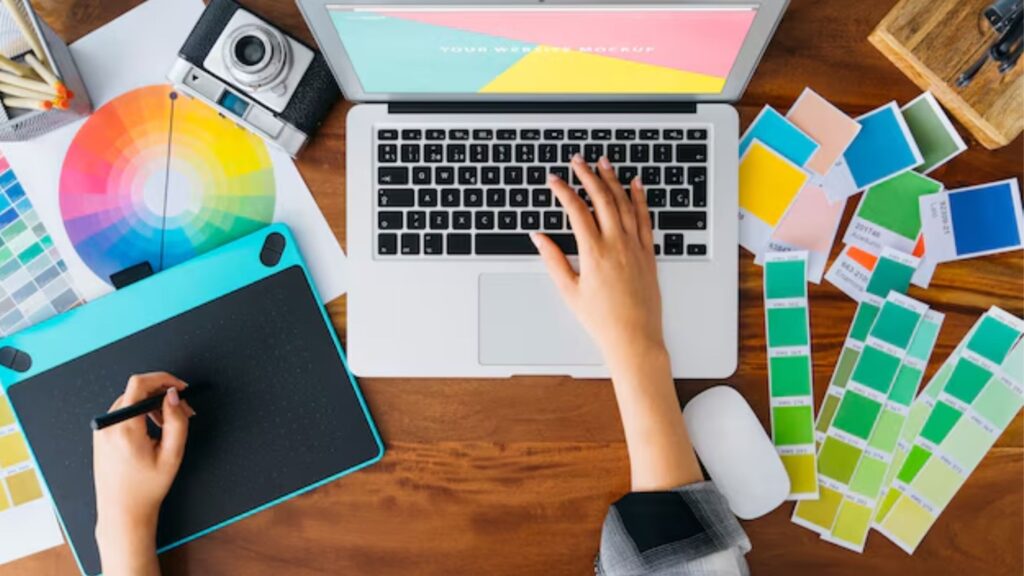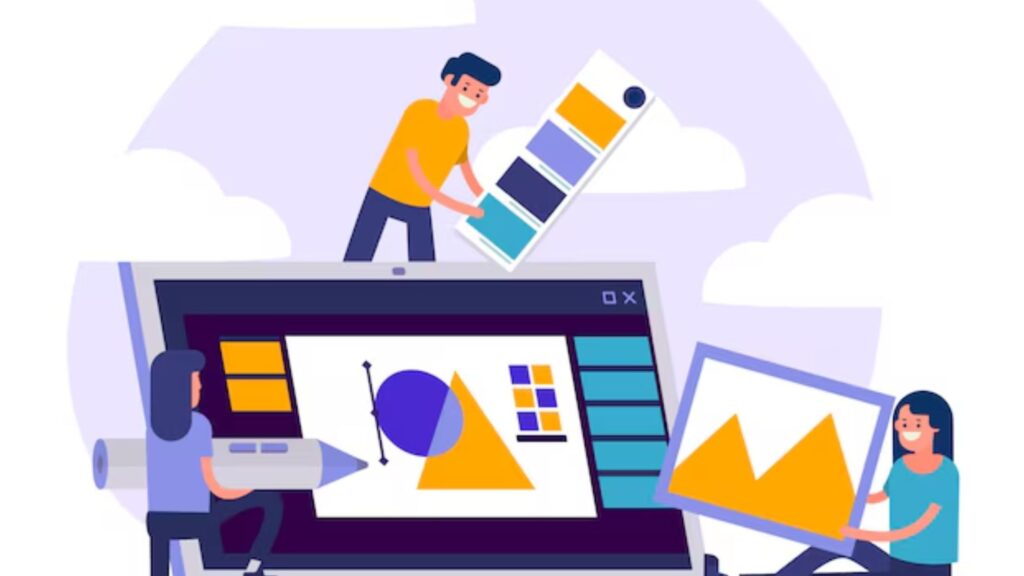Starting a graphic design business can be an exciting and rewarding opportunity, and the best part is that it doesn’t require a huge amount of investment. If you’re a design enthusiast looking to turn your creativity into a profitable venture, there are many ways you can do so within a budget. From using free and inexpensive tools to online resources, you can lay a firm foundation for your business without spending a large amount of money.

In this guide, we’ll walk you through practical tips and strategies for starting your graphic design business with minimal financial investment. We’ll discuss how to make the most of affordable software, create an effective portfolio, and effectively market your services. With these insights, you’ll be well-prepared to start your design career and build a successful business within a budget.
Table of Contents
1. How to Identify Your Specialization for a Graphic Design Business
Identifying a specialization is an important first step to starting a graphic design business. A specialization is the particular area you focus on, allowing you to tailor your services to a particular audience and differentiate yourself from competitors. Determining your specialization allows you to focus on an area you are skilled and passionate about, such as branding, web design, or illustration.

Focusing on a specialization helps you gain expertise in that particular area and build a strong portfolio, allowing you to attract clients who need these specialized services. For example, if you decide to specialize in branding, you can create overall brand identities for businesses, including logos, typography, and visual styles.
On the other hand, if web design is your specialization, you can provide services related to creating and customizing websites. By clearly defining your specialization, you can market yourself effectively and connect with clients who are looking for your specific abilities.
2. How to Create an Effective Business Plan for a Graphic Design Business
Creating a business plan is essential to establishing a clear guideline for your graphic design business. This plan guides your decisions and strategies as your business grows. First, clearly define your business goals, including both immediate objectives and long-term aspirations. Decide what you want to achieve, whether it’s getting a certain number of clients, generating a certain amount of revenue, or expanding your service offerings. Clear goals will help you stay focused and will be helpful in measuring your progress over time.
Next, identify your target audience. Understand who your ideal clients are so you can customize your services and marketing efforts to their needs. Consider factors such as industry, business size, and geographic location. Knowing the target audience will help you create relevant marketing strategies and position your brand effectively in the market.

Pricing strategy is an important part of your business plan. Decide how you will price your services, such as your expertise, complexity of projects, and market rates. Decide whether you will charge hourly rates, project-based fees, or based on retainer agreements. A well-thought-out pricing strategy ensures that you remain competitive while also achieving your financial goals.
Finally, create a marketing plan so you can promote your graphic design business. Outline what channels and strategies you will use to reach your target audience, such as social media, content marketing, or networking events. A strong marketing plan helps increase brand awareness, attract potential clients, and grow your business. By creating a comprehensive business plan, you establish a solid foundation for success and are prepared to take on the challenges of running a graphic design business.
3. Graphic Design Portfolio: How to Showcase Your Best Work
Creating a strong portfolio is a crucial step in establishing your graphic design business. A well-compiled portfolio showcases your skills, creativity, and versatility to potential clients. It should highlight your best work and provide a broad view of what you can offer. To be effective, make sure your portfolio includes a variety of projects. This variety shows your ability to handle different design challenges and meet different client needs.

Including a variety of projects in your portfolio can help you attract a wider audience. For example, if you have experience in branding, web design, and illustration, be sure to include examples from each area. This variety not only shows your adaptability, but also helps potential clients see how your skills can apply to their specific needs.
Additionally, consider including case studies or project descriptions that describe the design process and the results achieved. This approach highlights your problem-solving abilities and the value you provide to clients. By creating an attractive and diverse portfolio, you increase your chances of securing a variety of design projects and growing your business.
4. Establish an online presence: How to create a professional website and social media profiles
Establishing an online presence is crucial to promoting your graphic design business and reaching potential clients. A professional website is the foundation of your online identity. It should be well designed, user-friendly, and reflect your design style and expertise. Your website should include showcasing your portfolio, providing information about your services, and clear contact details. An effective website not only highlights your work, but also builds credibility and makes it easy for potential clients to contact you.

In addition to a website, establishing social media profiles is also important to engage with your audience and expand your reach. Platforms like Instagram, LinkedIn, and Facebook allow you to share your work, connect with industry professionals, and interact with potential clients. Regularly posting updates, background content, and design tips can establish your brand and keep your audience engaged.
Social media also provides a platform for networking and collaborating with others in the design community. By maintaining an active and professional online presence through both your website and social media, you increase your visibility, attract new clients, and establish your reputation in the graphic design industry.
5. Start Small and Expand Slowly: Grow Your Graphic Design Business Sustainably
Starting small and expanding gradually is a strategic approach to starting a graphic design business. Beginning with small projects gives you the opportunity to gain practical experience and develop your abilities without taking on excessive responsibilities.
These initial projects can be less complex, allowing you to focus on refining your craft, understanding clients’ requirements, and managing your time effectively. Successfully completing small projects can also lay the foundation for trust and credibility with your clients.

As your business grows and you gain more experience, you can gradually handle larger and more complex projects. This phased approach not only minimizes risk, but also allows you to build a strong portfolio that demonstrates your ability to handle a variety of projects. With each successful project, your reputation will strengthen, and you will be in a better position to attract high-profile clients and larger contracts. Expanding in this way ensures the steady growth of your business, allowing you to handle increasing responsibilities and complexities with greater ease and confidence.
6. Estimated investment to start a graphic design business: ₹60,000 to ₹80,000
Starting a graphic design business generally requires an investment of ₹60,000 to ₹80,000. This investment covers several important components that are needed to successfully launch and operate the business. First, a large portion of the budget will be spent on purchasing or upgrading a good computer, which is necessary to run design software effectively. In addition, it is important to invest in professional design software, such as Adobe Creative Cloud, although cheaper or even free options are also available if needed.

A professional website and domain setup is also a significant expense. This includes the cost of website design and hosting services, which can range from ₹5,000 to ₹15,000. A well-designed website is essential to showcase your portfolio and attract clients. Marketing and branding efforts also require funding, including getting business cards made and running online ads, which can add ₹5,000 to ₹20,000 to your budget.
Developing a strong portfolio is also an investment area, the cost of which depends on whether you build a portfolio website or prepare print materials. Eventually, miscellaneous expenses like professional subscriptions, training, or design resources may also be necessary. Overall, an estimated investment of ₹60,000 to ₹80,000 provides a solid foundation for starting your graphic design business, including necessary equipment and initial marketing efforts.
7. Getting feedback to improve and grow graphic design business
Getting feedback and continually improving is a key aspect of growing a successful graphic design business. Regularly receiving feedback from clients and peers provides valuable information about your work and business practices. Clients can report how well your design meets their needs, whether or not the project was completed on time, and the effectiveness of your communication. This feedback helps identify areas where you may need improvement and ensures that you are meeting or exceeding client expectations.

Also, it is important to receive feedback from peers and industry professionals. Peers can provide constructive criticism on your design approach, techniques, and overall creativity. Their information can help you stay up to date with industry trends and best practices. Joining design communities or forums can provide diverse perspectives and innovative ideas that can inspire and challenge you.
By actively seeking and incorporating feedback, you can continually grow your capabilities, adapt to changing client needs, and improve your overall business practices. This process of continuous evaluation and improvement is essential to maintaining high standards and achieving long-term success in the competitive field of graphic design.
8. Stay updated on trends and improve skills to maintain a competitive edge in graphic design
Staying up to date with industry trends is crucial to maintaining a competitive edge in the dynamic field of graphic design. The design world is constantly evolving, with new techniques, tools, and aesthetic trends emerging on a regular basis.

By staying informed of these developments, you can ensure that your work stays relevant and innovative. This may include following industry blogs, attending webinars, joining design conferences, and interacting with professional communities. Staying up to date will enable you to adopt new design practices and incorporate leading-edge ideas into your projects, increasing the quality and appeal of your work.
At the same time, constantly improving your abilities is also of utmost importance. As technology advances and design trends change, it is essential to invest time to learn and master new tools and techniques. This may include taking online courses, experimenting with new software, or practicing advanced design methods. By constantly improving your abilities, you not only keep your work fresh and creative, but also establish yourself as a versatile designer who is able to handle diverse client needs. This proactive approach ensures that you remain at the forefront of the graphic design field, making you more attractive to potential clients and employers.
Conclusion
In conclusion, starting a graphic design business can be an inexpensive and effective way to make a living if you use the right strategies and resources. By starting with a small investment, you can gradually grow your business and move towards a successful career. By using your design skills correctly, combining creativity and business approach, you can not only share your art but also build a stable and profitable business. By following these simple and practical tips, you can take your graphic design business to new heights.
If u want to Watch the Video You can visit to our You tube Businovations Channel and watch the video……
Click the link to read the Recent Posts….
How to Start a business with Zero Investment (163)


1 thought on “Graphic Design Business Without a Big Investment: Tips and Strategies (164)”